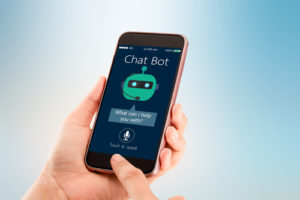The higher ed space is evolving as more schools look to implement artificial intelligence (AI) in a variety of ways to stay innovative. From discussions of AI replacing educators to helping students enroll, universities are looking to use this technology to improve student engagement and retention both in the classroom and on campus. Many higher ed institutions use AI through chatbots, allowing an automated form of communication between staff and incoming or even current students. These chatbots help inform students by answering common questions about tasks like enrollment and financial aid. While there are positive returns on implementing this type of technology, chatbots are not the future of student engagement in higher ed because they lack several crucial aspects.
These aspects cause chatbots to fall behind when compared to one-on-one communication between students and higher ed advisors or educators. Below are two notable reasons why chatbots are not the future of student engagement, along with what a more engaging solution looks like.
(Next page: The pros and cons of chatbots)
Students still require personal expertise
There will always be common student questions that chatbots can be programmed to easily answer, like how much a parking pass costs or when the writing center is open. However, students often seek guidance from faculty members with more specific questions where the answers might differ, depending on the student. These questions range from which professor best suits their academic needs to assistance selecting a major. A recent study found that 44 percent of adults sought advice from their college and high school counselors when choosing a major—a big decision for college students that should not be set in stone from a chatbot response.
While machine learning allows chatbots to learn and improve the overall user experience, many students still seek expert opinions, which data cannot always supply, instead of factual answers. These questions can only be answered with the expertise of a staff member, as there are many factors surrounding the student, university, classes, and more. A chatbot does not fully understand these factors and therefore might not be the most reliable source for students.
Human emotion helps build meaningful relationships
Not only will students ask experience-related questions that chatbots struggle to answer, but chatbots cannot fully understand the sentiment around a nervous freshman’s questions about scheduling classes or choosing a career path. Students asking personal questions should be met with empathy. Without empathy, universities miss the opportunity to understand their diverse student populations and, while scientists are working to create an “emotional chatting machine,” we are far from having a robot that can fully understand and reciprocate human emotion.
Chatbots can streamline student communication and work quickly, but that doesn’t mean they’re the best way to engage students. Educators still have to work hard in the classroom to connect with students and foster meaningful relationships, and students expect the same connection on campus. Having a faculty member at the other end of the communication is crucial to empathize with students and build positive relationships.
The solution
AI is emerging in nearly every industry—and higher ed should take advantage of the technology—but students still need to feel connected and experience more human interaction. This is why, when it comes to communicating with students, more colleges are meeting students’ needs through blended messaging™. This approach gives universities the option to create and schedule automated text messages and responses for those frequently asked questions, but also allows staff members to respond one-on-one with students to assist with more personal questions.
Texting students has grown in popularity, as more than 63 percent of teens text daily and only six percent exchange emails. One-on-one interactions provide the best support, as students who exchange three or more messages with their advisors have higher GPAs and are more likely to persist into the following semester.
Blended messaging™ gives higher ed the best of both worlds by implementing AI technology without losing the personal touch that students want. While technology will continue to change and improve how higher ed engages students, it’s important to not discount the value of building meaningful one-on-one relationships with students.
- Survey: More students want to go to graduate school - April 24, 2024
- Educause, AWS launch generative AI readiness assessment tool for higher ed - April 23, 2024
- A bungled FAFSA rollout threatens students’ college ambitions - April 19, 2024

